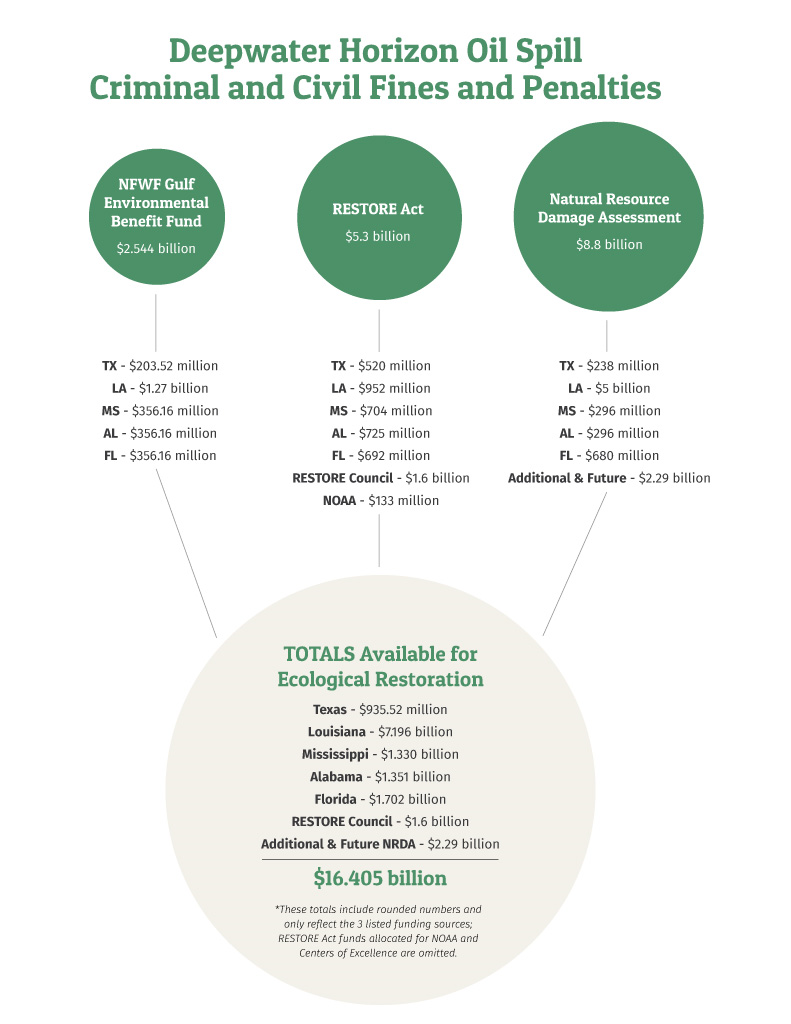Oil Spill Funding
How Deepwater Horizon Settlement Funds Can Help Restore the Gulf of Mexico
More than $16 billion is available for ecological restoration in the Gulf.
On April 4, 2016, the Department of Justice and the five Gulf states finalized a global settlement with BP for $20.8 billion dollars, to be paid out over the next 15 years.
Of this sum, $4.4 billion will flow back to the Gulf region via the RESTORE Act to be used for ecosystem and economic restoration and recovery efforts. Another $8.8 billion is available under the Oil Pollution Act’s Natural Resource Damage Assessment process to restore the places and wildlife damaged by the spill and the lost recreational use during the spill. Additionally, in 2013, the Justice Department structured its criminal settlements with BP and Transocean so that $2.54 billion of these penalties would be administered by the National Fish and Wildlife Foundation to fund projects that benefit the Gulf Coast natural resources impacted by the spill.
With the smaller civil settlements from Transocean and Anadarko, more than $16 billion is available that could be used for ecological restoration in the Gulf. With this money, the nation is going beyond just compensating a region for environmental harm done; we are embarking on the largest restoration effort in U.S. history.
 Seven years after the Deepwater Horizon rig exploded, this restoration process is really just getting started. The largest dollar amounts – those from the 2016 global settlement with BP – begin to pay out in 2017.
Seven years after the Deepwater Horizon rig exploded, this restoration process is really just getting started. The largest dollar amounts – those from the 2016 global settlement with BP – begin to pay out in 2017.
At the end of 2016, a federal-state council created by the RESTORE Act approved an important update to its statutorily mandated Comprehensive Plan for Gulf-wide restoration. This plan will guide how more than $3 billion of these restoration dollars are invested. The months to come are also a critical time for the Oil Pollution Act’s Natural Resource Damage Assessment process, as initial plans are published for various restoration areas – including one for each state and one for marine resources in the open ocean.
Maximizing this unprecedented opportunity will require vision, coordination, and a commitment to science. It will require decision-makers to think big and act boldly. And it will require active engagement by the people who live, work, or play on the Gulf Coast.
This document lays out the restoration projects the National Wildlife Federation believes will best advance a comprehensive Gulf-wide restoration agenda. Our long history working in the Gulf has given us a first-hand, up-close view of the important role estuaries play in supporting fish and wildlife. Thus we are focused on projects we think will improve the health of Gulf estuaries, directly or indirectly. We believe supporting estuaries – the nurseries for marine life and the foundation of coastal ecosystems – will give us the greatest return on this historic investment in ecological restoration.
